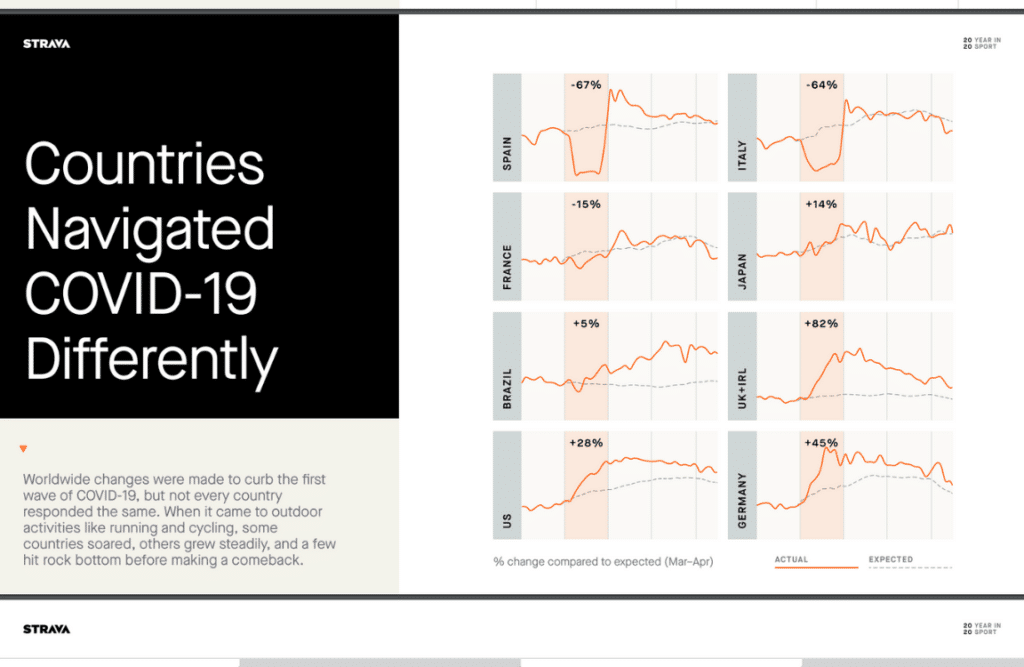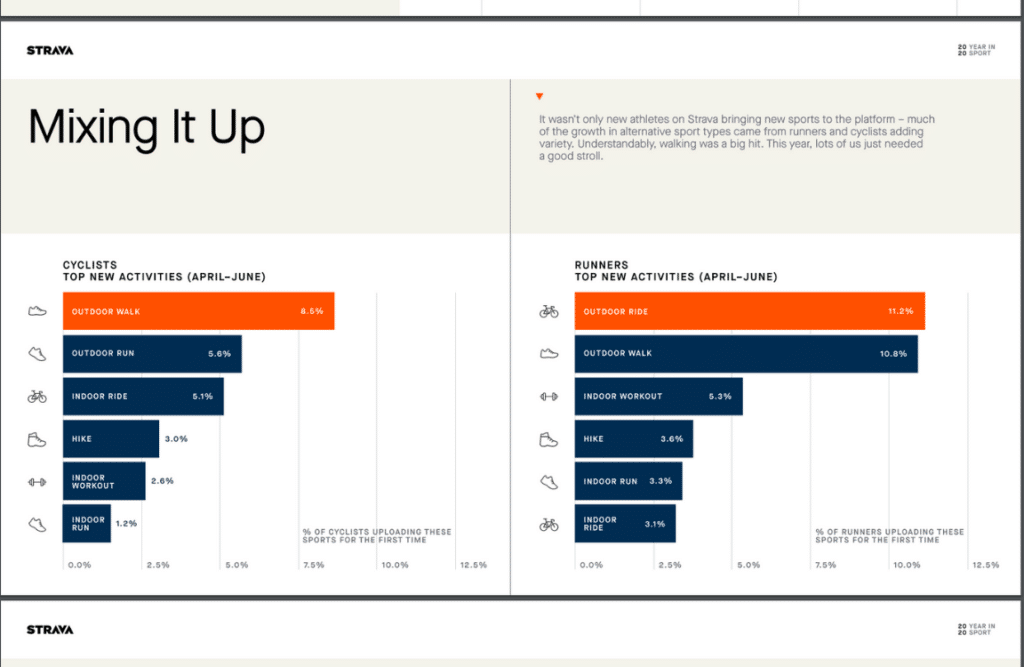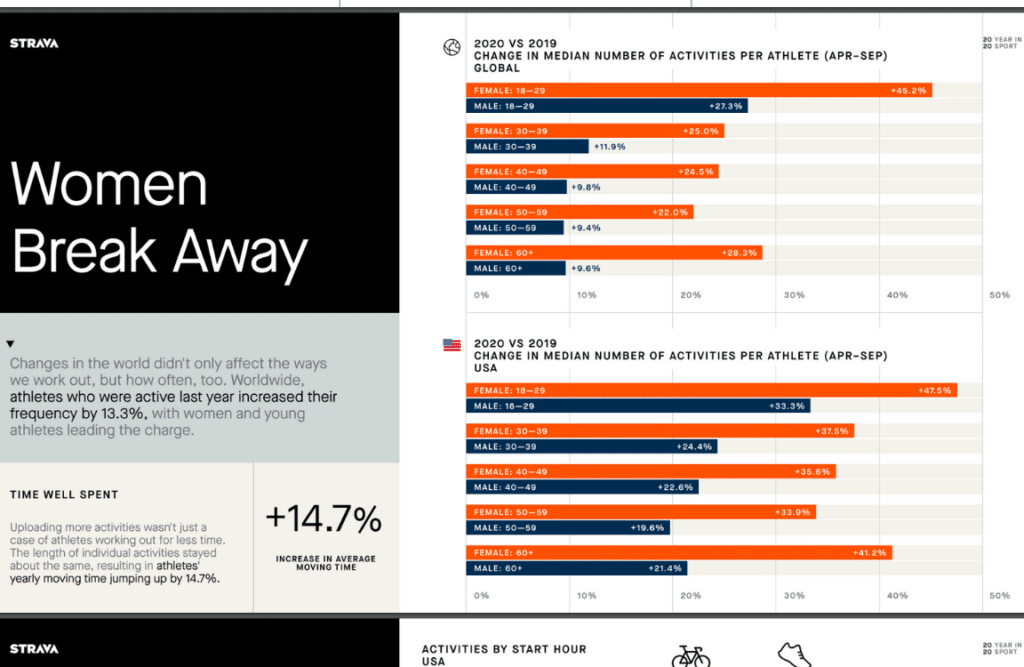
Takeaways and Predictions from Strava’s 2020 Year In Sport Report
By Chris Carmichael,
Founder and Head Coach of CTS
Strava released its annual “Year in Sport” report last week, putting some hard numbers to many metrics I think many people assumed had increased due to the pandemic. Anyone looking to purchase a bicycle or get replacement parts in 2020 knows they were in short supply. The same has been true for hiking, running, camping, and other outdoor gear. The report contains a lot of interesting information, and here are some my big takeaways and predictions for 2021.
We are wired to be active
When normal avenues for movement – including those related to work, family, and sport – were limited, people were drawn to find new ways to be active. In places like Spain and Italy– which were affected early and extensively, and before much was known about the virus – the number of outdoor activities dropped precipitously in March and stayed depressed into April, while indoor activities increased. However, in France, outdoor activities only dipped a little bit before rebounding. Strava then separated out outdoor runs and rides, and found that an increase in running activities offset a deep drop in outdoor cycling.
As in France, the changes in uploaded outdoor activities in March and April echoed the level of restrictions to mobility in different countries. France restricted exercise to one kilometer from your residence, making running preferable to cycling. Countries like the US that had few restrictions on movement saw immediate increases in uploaded outdoor activities.
Humans are not designed to be sedentary, nor are we mentally wired for it.
People still prefer to go outside
There’s no doubt the pandemic led to a boom in indoor cycling and running, as well as and home-based strength training. It has been a great year for virtual cycling apps, and smart trainers are selling as fast – or faster – than companies can make them. The indoor training experience is improving, but the Strava report shows people still want to go outside.
Athletes who uploaded a new activity types (cyclists uploading runs, runners uploading rides, etc.) for the first time increased, led by outdoor activities. Certainly, economics play a role here. Going for a walk or run outside, or pulling that old bicycle out of the garage, is relatively inexpensive compared to the startup costs for indoor trainers (especially smart trainers) and/or treadmills. There’s a seasonality component as well. The pandemic hit during winter in the northern hemisphere. Strava’s published data on athletes uploading new sports for the first time is from May – June, when warmer weather made outdoor activities more appealing.
Existing athletes trained more in 2020
There were a lot of new athletes uploading activities to Strava in 2020 (they added 2 Million new members per month), and the athletes who had Strava accounts in 2019 increased their activity level: activity frequency jumped by 13% and total moving time increased nearly 15%. Across all age groups, women increased the number of uploaded workouts more than men did. The biggest increase was from women in the 18-29 age group, followed by women in the 60+ age group.
► Free Cycling Training Assessment Quiz
Take our free 2-minute quiz to discover how effective your training is and get recommendations for how you can improve.
The data on increased training frequency and duration echoes what we’ve seen with CTS Athletes. Working from home eliminated hours of commuting, which reduced the competition for time across exercise, family activities, and other priorities. Reduced travel for either work or vacations led to more consistent training, which added to the number of training sessions completed per month.
What The Strava Year In Sport Means for 2021
Outdoor Events Will Come Roaring Back
We’re all pacing around our houses like caged animals, itching to get back to the events we couldn’t go to in 2020. Between improved health procedures and vaccines that will hopefully help bring the virus under control, event companies are going full steam ahead with planning. A few weeks ago, the SBT GRVL event sold out in minutes. Yes, there’s still a risk you might not be able to go to a particular event, but if you wait it’s likely you won’t be able to get an entry anyway.
Competition level is going to go up in 2021
If you’re a competitor, be prepared for fields to be more competitive than in 2019. Not only is there an influx of athletes from other sports (rowers racing bikes, ultrarunners getting into mountain biking, everyone gravitating toward gravel), but some of those reliably mid-pack local racers from years past are going to be pushing to the front of the pack. Obviously, I’d recommend working with a coach to get ready.
Opportunity to aim for big goals
Many athletes will start 2021 with a bigger base of fitness than they normally have at the beginning of the year. And many goal-oriented athletes, also spent a significant portion of 2020 targeting their weaknesses and filling in gaps in their fitness. With CTS Athletes, we’ve seen greater rates of improvement in power/pace at lactate threshold, time to exhaustion at threshold, and power-to-weight ratios than in previous years. For instance, you can read about cyclist DJ Brew’s progress in 2020. Those gains are going to carry into 2021. Don’t squander this opportunity to go for your biggest, most meaningful goals.
Athletes are going to continue integrating indoor/outdoor training
Many athletes who didn’t really consider indoor training for endurance sports, or at-home strength training, are much more comfortable with it now. They’ve evaluated their options and made some choices that fit best into their lifestyle and home environment. Throughout 2020 we’ve seen training consistency improve, meaning people who primarily train outdoors are missing fewer workouts because they have the equipment and willingness to train indoors if they can’t get outside. In the long run, training consistency is one of the most impactful ways for athletes to improve performance, manage bodyweight, prevent injuries, and create healthy habits.
A Word of Caution on Reading Too Much Into Report
Strava saw increased frequency, number, and duration of activities, but that only accounts for the people with Strava accounts. You can argue that the activity habits of Strava’s demographic might not be representative of what’s going on at the population level. There is a huge portion of the US population that became less active. One potential cause for concern is that this could lead to greater disparity in long-term health outcomes: those who could be more active did some great things for their health and fitness, whereas those who were already vulnerable to poor health outcomes due to sedentary lifestyles became more so. Preliminary reports indicate a decrease in activity in the US population and worldwide overall for periods between February and April. In the US, these decreases were most pronounced for low-income and Hispanic/Latino adults. So, it’s great that athletes improved fitness and performance, and that people who already led active lifestyles adapted to maintain or increase activity levels, but there is still a lot of work to be done to increase access to exercise and outdoor sports in the broader US population.
► FREE Mini-Course: Learn How to Maximize Your Limited Training Time
Learn step-by-step how to overcome limited training time and get faster. Walk away with a personalized plan to increase your performance.
"*" indicates required fields





Comments 3
I think working from home was a big reason for increased activity. Many people spent inordinate amounts of time commuting. Also if you work at home, you likely have a more flexible schedule and can workout when weather is better or when your children are in virtual school.
And I think many companies will realize there is no need for everyone to come in to a high priced office facility so working from home will continue for many.
Thank you for your analysis, but I believe there may be a large drop in the Strava numbers when businesses and schools reopen. So much of the increase I believe is only due to boredom.
Super interesting . Tks for the synopsis.